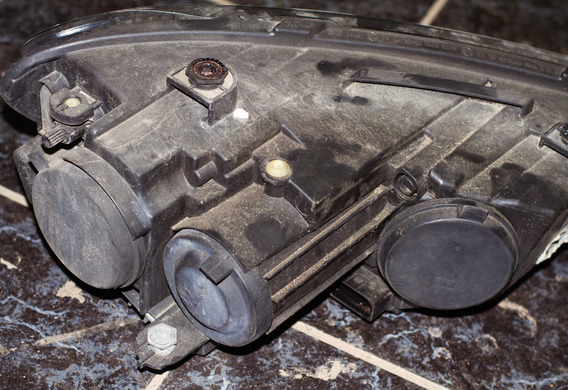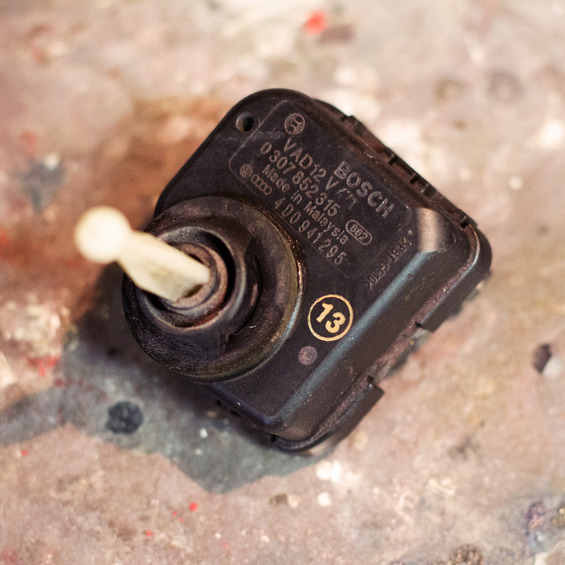
In the process of motor industry development, the design of the headlights has become more complicated and, after some time, they have started to be equipped with a device that limits the height of the light emitted from the beam. This conditional boundary in the theoretical lining of the headlamps is referred to as the "cut-off" or the SUT (light-shadow border).
The "old pattern", which was approximately from the 1960s to the 1990s, could be adjusted in advance, and the height of the border remained static. Cars of the later period have started to be equipped with a device which allows to adjust the height of the border during the course, making it higher or lower, depending on the terrain and the load on the car.
The dynamic change devices of the SUT are referred to as correctors. Of course, it should be stated that, on the one hand, in the form of the option they were offered earlier, for example, in the "Five" BMW E32 in some picking, and on the other, the headlights without the proofreaders are found on the cars of the current model year, but in general these devices have ceased to be rare in our time

Types of headlamp adjusters
The proofs are divided into two types-driven by the driver and automatic, controlled by electronics.
The design of the proofs according to the type of the headlamp may also be of different types-mechanical, hydraulic, pneumatic and electromechanical devices.
Which type of adjustment is installed in your car depends on the brand, year of release, and type of headlamp. The most common electromechanical proofers are encountered, equipped with cars with halogen headlamps in the middle of the nineties and later.
electromechanical proofreader
The device is controlled by the driver, but to the lowering and lifting of the headlamps not required, the driver only steals a potentiometer wheel with the marks and serial numbers located to the left of the steering column on the panel. The degeneration (numbered, usually numeral from 1 to 4) corresponds to the cut-off level-the greater the number, the higher the light. All the distance from the bottom to the upper point of the rise may be divided into equal sections, each of which corresponds to division, in which case the headlamp shall be raised and down or the aiming may be carried out smoothly. In such a case, the lamps may be adjusted to the height of precision.
The construction of each unit-the headlamp shall include a motor gear consisting of an electric motor, a worm gear, and a component board. The electronic circuit board regulates the operation of the device. The reductor turns the continuous rotation of the shaft electric motor into the forward movement of the shaft of the headlamp height. At the end of the ball, there is a mobile Jointed Jointed Jointed Jointed Jointed part of the reflector body. The motor shall lift and lower the mashup, and the latter in turn pushes the hull of the reflector and raises or omits the headlamp.
Mechanical correction
Hydromechanical proofers are generally similar to electromechanical work. The difference is only in the type of drive and in the absence of electronics. As with the electromechanical proofreader, the driver rotates the wheel with the marks located on the front panel. However, it does mechanical work, that is, the fingers have an impact on the headlights, moving them, although the strength of the fingers has been strengthened many times by hydraulics. Headlamps are mechanical, but the force of the driver's fingers is transmitted to the mechanism by means of a liquid in the tube.
Mechanical correction
It is different from hydromechanical only to the absence of a hydraulic system. In this type of correction, the force developed by the fingers of the driver is transmitted by mechanical means (through a rotating cable) and amplifiers by the gearbox. It is precisely thanks to the reductor that is able to move up-down the headlamp (a lot of forces are needed to move them).

Automatic adjuster
The electromechanical actuator does not differ, but the device is not controlled by a person, but by electronics. Changing the inclination of headlamps equipped with an automatic electromechanical proofreader does not occur without human intervention. The computer program that the device processor performs regulates the inclination of the headlamps according to the specified algorithm. For example, it increases the beam of light if the car rolls downhill, or lowers it if the other car enters the meeting in the road.
In the determination of the required height, the microprocessor electronic controller is based on telemetry obtained from the ground clearance sensors.
Several sensors, usually one or two leading (left and right), and a third in the tail section, are installed to correct the readings. The sensors used in modern models are based on Hall effect, with the use of potentiometer sensors on older vehicles.
The body of the sensor is attached to the body and is connected in a flexible traction with the suspension lever. The suspension shall therefore be recorded and the changing output of the sensor to be synchronized. The electronic controller monitors the sensor signal changes and shall measure them with the parameters in memory. Depending on these parameters, the executive mechanisms of the headlamps (similar in design with similar mechanisms applied in the electromechanical correcting) shall be ordered to lift or lower the lens, changing the height of the light beam.
In the more budgetary design, a single ultrasonic sensor is used to obtain the data, attached to the tail of the body on a spherisle and scan distance to the road.
It is worth mentioning separately that according to GOST R 51709-2001, all modern cars with xenon headlamps should be equipped with automatic adjustment of the light. Accordingly, if the owner of the vehicle installs the xenon headlamps on its own, it shall order the installation of automatic headlamp-proofing lamps so as not to infringe the existing legislation.







